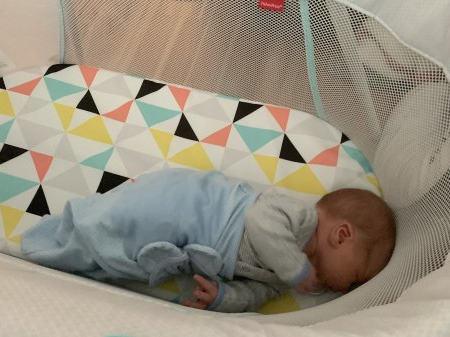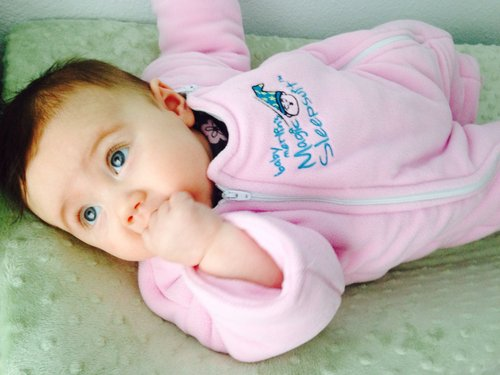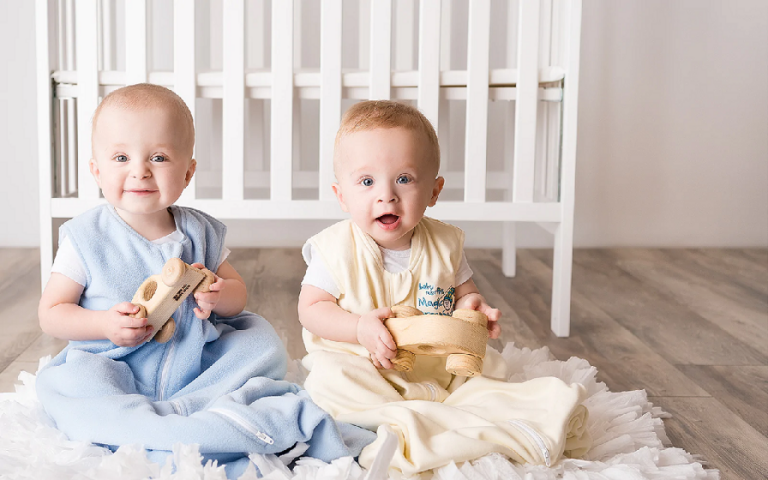Why Baby Moves To Side of Bassinet [ & What to Do ]

Safe sleeping positions is an emphasized subject among new parents. Therefore, waking up to the baby on the side of the bassinet with the face smashed against the bassinet wall is a major concern for many parents, and hence the question, is it safe if the baby moves to the side of the bassinet?
It is usual for babies to move around the bassinet even before they learn to roll over. Therefore, do not panic to find your baby on the side of the bassinet and especially if the bassinet is still age-appropriate, has mesh sides, and there are no extra clothes or objects inside.
From the age of 8 weeks, babies become active sleepers. The sleeping positions of babies at this age are shocking and beat the famous phrase “sleep like a baby.”
In this article, we will look at the significant reasons why babies move to the side of the bassinet and tips on how to ensure the baby’s safety.
It is usual for the baby to wiggle and move around the bassinet. You should be concerned if the baby is not making any movements.
Now that it is not something to worry about, let us look at some main reasons why babies move to the side of the bassinet:
Why Baby Moves To Side of Bassinet
Seeking comfort
Most babies find their way to the sides of the bassinet and even sleep with their faces on the wall in search of comfort. This is the only place where the baby gets a snuggly feeling in a bassinet set up.
Having the baby press their face against the wall is risky but the risk can be reduced by investing in a bassinet with mesh sides to allow for air circulation.
Active sleep patterns
Babies have active sleeping patterns because most of their sleep is spent in the dream cycle (REM sleep). According to experts, babies exhibit twice REM sleep as adults. What’s more, their REM patterns are shorter, with a possibility of waking up after every session.
Therefore, babies wake up more and thus end up moving around more in sleep, and this might land them at the sides of the bassinet.
Body adjustments
Like adults, babies need to stretch and adjust their bodies in sleep to search for comfort. Therefore, they will toss around until they find a comfortable sleeping position, which might be the bassinet’s side.
See also what to do when baby sleeps with face planted in mattress
Function of survival
Some experts explain baby movements in sleep as instinctual and necessary for survival. If the baby sleeps sounds at night, they might not clear their airways or cry to communicate that their diapers are soiled.
Therefore, it is normal and innate whether your baby presses their face on the bassinet wall or turns upside down.
Resists swaddling
Swaddling calms and helps most babies to sleep better and longer at night, but some babies do not like the idea of being wrapped. If your baby falls on the latter, they will move in an attempt to break loose from the swaddle.
Babies who do like being swaddled like to suck their thumb or touch their face in sleep. To reduce the movement of such a baby, wrap her with one arm or both outside or use light cotton swaddles. You might also have to consider other types of sleepwear if your baby cannot settle when swaddled.
See also What to do when baby hates swaddle but startles
The baby wants to move closer to the parents
A parent’s warmth is the best thing you can offer a newborn. Therefore, some babies move to the side of cribs, trying to get closer to their parents.
If this is the case, pull the bassinet closer to your bed so that the baby doesn’t have to move around looking for you.
What To Do When Baby Moves to Side of Bassinet
Baby’s movements in sleep are normal and unavoidable. If you were to control the sleeping positions of your baby, it would mean staying up all night to watch over them which is impossible.
The best you can do as a parent to ensure that your baby is safe irrespective of the sleeping position, is to give them a safe sleeping environment.
The tips below will help you to keep the crib safe for side sleeping:
No bumpers
Bumpers were designed to protect the baby from moving to the sides of the bassinet. However, their softness puts the baby at the risk of suffocation.
If the baby presses their face against the bumpers and cannot move away, they will not breathe freely, resulting in suffocation.
Get rid of blankets or stuffed toys
Just like bumpers, any soft object or cloth in the bassinet puts the baby at the risk of suffocation. Therefore, keep the bassinet clear of these items, and you will have nothing to worry about even if the baby presses their face against the bassinet wall.
A firm mattress that fits the bassinet
Ensure that the mattress in the bassinet is fitting and firm. A small-sized mattress leaves a space between the mattress and the walls of the bassinet, where the baby can slide and suffocate.
Also, a soft mattress can sink in, allowing the baby to move to the sides.
See also Why baby hates halo bassinest
Change the swaddling technique or stop swaddling
If your baby hates swaddling, they will be restless trying to break loose from the wrap throughout the night. For such a baby, swaddling is risky.
They are most likely to roll over on the belly or press their face on the bassinet wall and suffocate because they cannot roll over back to a safe sleeping position.
Purchase a bassinet that meets the safety standards
There are numerous beautiful bassinets; unfortunately, some do not meet the bassinet safety requirements. Therefore, when purchasing a bassinet, look at both the beauty and its safety. A safe bassinet, for example, should have mesh walls to allow for air circulation.
Certified bassinets from reputable sources will cost you more than other bassinets, but you will be assured of your baby’s safety.
With a safe bassinet, you do not have to keep on repositioning your baby. However, if your baby seems uncomfortable on the sides, move them to a comfortable position.
Can Baby Suffocate on Side of Bassinet?
Babies can suffocate on the sides of the bassinet if they press their face against the wall or meet soft objects like bumpers. To avoid such instances, purchase a bassinet with mesh walls because they offer airflow. Also, get rid of any soft blankets, bumpers, or stuffed objects from the bassinet.
Other than airflow, mesh wall bassinets help you to visually monitor your baby. If you are shopping for a bassinet and your option does not feature meshed walls, it is time to reconsider.
See also Why baby sleeps with head tilted back
FAQ on Baby Moves to Side of Bassinet
How Do I stop My Baby from rolling in the Bassinet?
Baby’s movement in the bassinet is natural; you cannot control or stop it. Therefore, parents should only invest in what they can handle: the sleeping environment.
Ensure that the crib is safe by purchasing a crib with mesh walls, a firm and fitting mattress, and getting rid of soft clothes and objects from the bassinet.
How Do You Know the Baby has Outgrown the Bassinet?
A baby has outgrown the bassinet; if they have surpassed the bassinet weight limits and age limits, can they roll over or stand up independently or if the space is too small to accommodate current baby movements in sleep.

![7 Reasons Why Baby Hates Bassinest [& What To Do]](https://parentportfolio.com/wp-content/uploads/2022/02/baby-hates-halo-basssinest.png)




